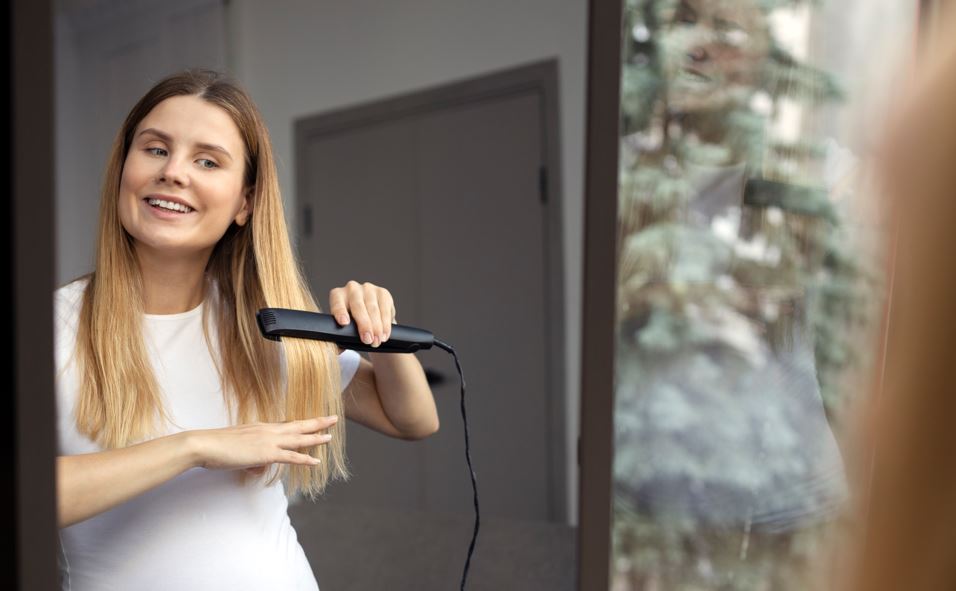Many people desire straight and sleek hair, leading them to explore various hair styling techniques such as hair straightening. While hair straightening can provide temporary transformation, it’s important to be aware of the potential side effects associated with this process. In this blog, we will explore the science behind hair straightening and discuss the possible side effects that can occur.

Understanding Hair Structure
To comprehend the side effects of hair straightening, it’s crucial to understand the basic structure of hair. Each hair strand consists of three layers: the cuticle, cortex, and medulla. The cuticle, the outermost layer, acts as a protective shield for the inner layers. The cortex is responsible for hair strength, elasticity, and colour, while the medulla is present only in thick hair and plays a minimal role in hair health.
Hair Straightening Techniques
Hair straightening techniques typically involve the use of heat or chemicals to alter the hair’s structure. The two common methods are:
1. Heat-Based Hair Straightening
This technique involves using heat-styling tools, such as flat irons or straightening brushes, to apply high temperatures to the hair shaft. The heat breaks the hydrogen bonds within the hair, allowing it to be reshaped temporarily. Once cooled, the hair retains the straightened shape until it is washed or exposed to moisture.
See also: How To Use Coconut Oil For Dandruff?
2. Chemical-Based Hair Straightening
Chemical-based hair straightening methods, such as keratin treatments or chemical relaxers, use chemical compounds to alter the hair’s structure. These treatments break the disulfide bonds in the hair, which are responsible for its natural curl or wave pattern. The chemicals soften and relax the hair, allowing it to be straightened.
See also: What to Apply Before Straightening Your Hair?
Potential Side Effects
While hair straightening can provide the desired appearance, it is important to consider the potential side effects associated with these techniques:
1. Hair Damage
Excessive heat or harsh chemicals used during hair straightening can damage the hair shaft, leading to dryness, brittleness, and breakage. The high temperatures from heat styling tools can strip the hair of its natural moisture, making it more prone to damage.
2. Scalp Irritation
Chemical-based hair straightening treatments may contain strong ingredients that can cause scalp irritation and allergic reactions. These reactions can manifest as redness, itching, and inflammation of the scalp.
3. Hair Loss
Repeated or improper use of heat-styling tools or chemical treatments can weaken the hair follicles and contribute to hair loss. Excessive heat can lead to thermal damage, while harsh chemicals can cause breakage and thinning of the hair.
4. Frizz and Flyaways
Although hair straightening aims to eliminate frizz and flyaways, improper techniques or inadequate maintenance can result in the opposite effect. Over time, the hair’s natural texture may become compromised, leading to increased frizz and difficulty in managing the hair.
5. Changes in Hair Texture
Chemical-based hair straightening treatments can permanently alter the hair’s texture. These treatments can make naturally curly or wavy hair permanently straight, which may be undesirable for some individuals.
Prevention and Minimization
To minimize the side effects of hair straightening, consider the following tips:
1. Limit the Frequency
Avoid excessive heat styling and chemical treatments. Limit the frequency of hair straightening sessions to give your hair time to recover and minimize damage.
2. Heat Protectants
Before using heat styling tools, apply a heat protectant spray or serum to shield the hair from excessive heat and minimize damage.
3. Proper Maintenance
Follow a regular hair care routine that includes deep conditioning treatments and the use of nourishing hair products. This helps restore moisture and keep the hair healthy.
See also: Does Coconut Oil Work For Your Hair Type?
Conclusion
While hair straightening techniques can provide temporary hair transformations, it’s important to be aware of the potential side effects. Excessive heat, harsh chemicals, and improper techniques can damage the hair, and cause scalp irritation, hair loss, and texture changes.
By understanding the science behind hair straightening and following preventive measures, you can minimize the risk of side effects and maintain healthier hair. Remember to prioritize the well-being of your hair and consult with professionals when necessary.
